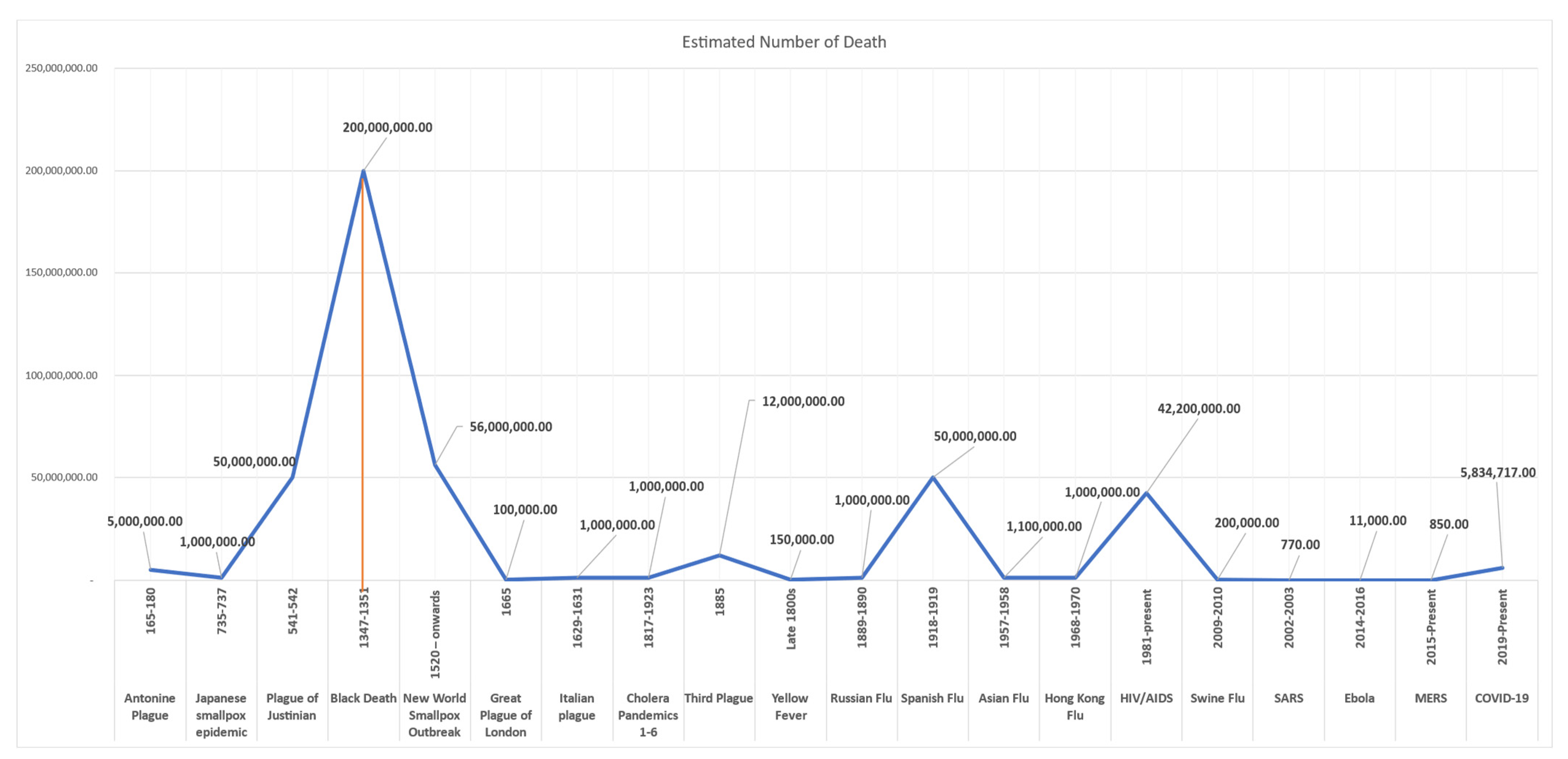Pandemic-Resilient Urban Centers: A New Way of Thinking for Industrial-Oriented Urbanization in Ethiopia
Abstract
:1. Introduction
2. Materials and Methods
2.1. Description of the Study Area
2.2. Methods
3. Literature Review
3.1. The Notion of Pandemic and Resilience
3.1.1. Pandemic
3.1.2. Resilience
“…the ability of urban systems to continuously develop short-term coping and long-term adaptation strategies—considering, and in response to constantly changing system dynamics and complexities over a range of spatial and temporal scales—to mitigate hazards, withstand and absorb shocks, rapidly bounce back to baseline functioning, and more effectively adapt to disruptive events by bouncing forward to better system configurations.”[16]
3.2. The Impact of Pandemics on the World Time Horizon
3.3. Planning Measures during the Time of Pandemic
3.3.1. Spatial Planning Measures
- (a)
- Zoning
- (b)
- Walkable Streets and Open Space Planning
3.3.2. Engineering Measures
3.3.3. Mixed Approach
4. Results
4.1. The Advent of Industrialization on the Railway Line in Ethiopia
4.2. Historical Insights of Industrialization and Urbanization in Ethiopia
- (a)
- The Imperial Era
- (b)
- The Dergue Regime (1974–1991)
- (c)
- Ethiopian People Revolutionary Democratic Front (EPRDF)—(Since 1991)
“a tract of land developed and subdivided into plots according to a comprehensive plan with the provision of roads, transportation and public utilities, sometimes also with common facilities, for use by a group of manufacturers”[40].
“area with distinct boundary … to develop comprehensive, integrated, multiple or selected functions of industries, based on a planned fulfilment of infrastructure and various services such as road, electric power and water, one-stop-shop and have special incentive schemes, with a broad view to achieving planned and systematic, development of industries, mitigation of impacts of pollution on environment and human being and development of urban centers, and includes special economic zones, technology parks, export processing zones, agro-processing zone, free trade zones and the like …”[42].
4.3. The Nexus of Urbanization and IPs
4.4. The Prospects of Industrial Parks for Cluster Cities’ Formation in Ethiopia
4.4.1. Location
4.4.2. Population Agglomeration
4.5. The Impact of COVID-19 on IPs-Oriented Clustered Cities
4.5.1. Economic Impacts
- (A)
- Investment Attraction
- (B)
- Financial Impact
4.5.2. Social Impact
4.6. Measures to Combat the Impact of COVID-19
4.6.1. Government Measures
- (A)
- Restriction Measures
- (B)
- Design and Implementation of Norms and Standards
- (C)
- Incentives
- (a)
- Incentives targeted at encouraging investors with no order from abroad for the past two months and those who lost procurement agreements from their clients abroad. They are allowed to sell their products within the local market;
- (b)
- Free transport of goods from Modjo dry port up to Djibouti port is available for all IPs investors;
- (c)
- A six-month discount cargo service is offered for the Ethiopian Airline cargo service’s customers.
- (D)
- Repurposing
4.6.2. Company Owners
5. Innovative Planning Measures
- (i)
- understanding the nature of the pandemic;
- (ii)
- developing in-depth knowledge of prevention and curative methods;
- (iii)
- designing an innovative planning measure;
- (iv)
- implementing it accordingly, in collaboration with stakeholders.
- (a)
- understand the salient features of COVID-19, such as the type of disease it is (viral or bacterial). In this case, COVID-19 is an infectious disease caused by a newly discovered coronavirus. The COVID-19 virus spreads primarily through droplets of saliva or discharge from the nose when an infected person coughs or sneezes;
- (b)
- collect relevant information to know the way to prevent the spread of the disease, as well as curative methods. Planners should collect relevant information from responsible entities. The World Health Organization (WHO) and the Ethiopian Ministry of Health, as well as the Public Health Institute, provides relevant information on the different prevention methods. Accordingly, some of the simple precaution measures advocated by relevant public health organizations are: physical distancing, wearing a mask, keeping rooms well ventilated, avoiding crowds, cleaning your hands, and coughing into a bent elbow or tissue;
- (c)
- develop science-based human-focused planning models. Once planners have sufficient knowledge of the cause and dissemination of the disease, they should develop simple, realistic, and implementable planning models that indicate the roles of different stakeholders.
6. Conclusions
Author Contributions
Funding
Institutional Review Board Statement
Informed Consent Statement
Data Availability Statement
Conflicts of Interest
References
- Afrin, S.; Chowdhury, F.J.; Rahman, M. COVID-19 Pandemic: Rethinking Strategies for Resilient Urban Design, Perceptions, and Planning. Front. Sustain. Cities 2021, 3, 668263. [Google Scholar] [CrossRef]
- UNCT. Socioeconomic Impact of COVID 19 in Ethiopia; UN Ethiopia: Addis Ababa, Ethiopia, 2020. [Google Scholar]
- Ahsan, M.M. Strategic decisions on urban built environment to pandemics in Turkey: Lessons from COVID-19. J. Urban Manag. 2020, 9, 281–285. [Google Scholar] [CrossRef]
- Rachmawati, R.; Mei, E.T.W.; Nurani, I.W.; Ghiffari, R.A.; Rohmah, A.A.; Sejati, M.A. Innovation in Coping with the COVID-19 Pandemic: The Best Practices from Five Smart Cities in Indonesia. Sustainability 2021, 13, 12072. [Google Scholar] [CrossRef]
- Hu, R. COVID-19, smart work, and collaborative space: A crisis-opportunity perspective. J. Urban Manag. 2020, 9, 276–280. [Google Scholar] [CrossRef]
- UNIDO. Responding to the Crisis: Building a Better Future; UNIDO: Vienna, Austria, 2020. [Google Scholar]
- UNDP. Understanding African experiences in formulating and implementing plans for emergence: Growing Manufacturing Industry in Ethiopia. In Proceedings of the Second Edition of International Conference on the Emergence of Africa (ICEA II), Abidjan, Ivory Coast, 28–30 March 2017. [Google Scholar]
- NPC. Growth and Transformation Plan II (GTP II) (2015/16–2019/20); National Planning Commission: Addis Ababa, Ethiopia, 2016.
- MOFED. Growth and Transformation Plan I (GTP I) (2010/11–2014/15); Ministry of Finance and Economic Development: Addis Ababa, Ethiopia, 2010.
- Tellier, L.N. Urban World History: An Economic and Geographical Perspective, 2nd ed.; Springer Nature: Cham, Switzerland, 2019. [Google Scholar]
- EIC, Ethiopian Investment Commission. Available online: https://www.investethiopia.gov.et/index.php/investment-opportunities/other-sectors-of-opportunity/overview.html (accessed on 14 February 2022).
- HOPR. Industrial Parks Development Corporation Estabilshment Council of Ministers regulation No. 326/2014; Federal Negarit Gazetate, Year 21st No. 2; Birhan Ena Selam: Addis Ababa, Ethiopia, 2014. [Google Scholar]
- Gray, D.E. Doing Research in the Real World; SAGE Publications: London, UK, 2004. [Google Scholar]
- Kothari, C. Research Methodology: Methods and Techniques; New Age International Publishers: New Delhi, India, 2004. [Google Scholar]
- Porta, M. Dictionary of Epidemiology, 6th ed.; Oxford University Press: New York, NY, USA, 2014. [Google Scholar]
- Yamagata, Y.; Sharifi, A. Resilience Oriented Urban Planning: Theoretical and Empirical Insights; Springer International Publishing AG: Cham, Switzerland, 2018. [Google Scholar]
- UNISDR. 2009 UNISDR Terminology on Disaster Risk Reduction; United Nation Office for Disaster Risk Reduction: Geneva, Switzerland, 2009. [Google Scholar]
- Zhou, C.; Su, F.; Pei, T.; Zhang, A.; Du, Y.; Luo, B.; Cao, Z.; Wang, J.; Yuan, W.; Zhu, Y.; et al. COVID-19: Challenges to GIS with big data. Geogr. Sustain. 2020, 1, 77–87. [Google Scholar] [CrossRef]
- UNISDR. Sendai Framework for Disaster Risk Reduction 2015–2030; The United Nations Office for Disaster Risk Reduction: Geneva, Switzerland, 2015. [Google Scholar]
- Wallace, D.; Wallace, R. Urban systems during disasters: Factors for Resilience. Ecol. Soc. 2008, 13, 112. [Google Scholar] [CrossRef] [Green Version]
- Lazarević, V.E.; Keković, Z.; Antonić, B. In search of the principles of resilient urban design: Implementability of the principles in the case of the cities in Serbia. Energy Build. 2018, 158, 1130. [Google Scholar] [CrossRef] [Green Version]
- Lak, A.; Hasankhan, F.; Garakani, S.A. Principles in practice: Toward a conceptual framework for resilient urban design. J. Environ. Plan. Manag. 2020, 63, 2194–2226. [Google Scholar] [CrossRef]
- Worldometers. Worldometers: Corona Virous. Available online: https://www.worldometers.info/coronavirus (accessed on 14 February 2022).
- History.com. Hisitory. Pandemics That Changed Hisitory, 30 January 2020. Available online: https://www.history.com/topics/middle-ages/pandemics-timeline (accessed on 14 February 2022).
- UNAIDS. UNAIDS: Global HIV & AIDS Statistics 2020 Fact Sheet, UNAIDS. Available online: https://www.unaids.org/en/resources/fact-sheet# (accessed on 4 November 2020).
- CDC. CDC: History of Quarantine, Centers for Disease Control and Prevention. 20 July 2020. Available online: https://www.cdc.gov/quarantine/historyquarantine.html (accessed on 14 February 2022).
- Shun’ichi, I. JSTOR: Oranda Fūsetsugaki Shūsei. Monumenta Nipponica. 1979. Available online: https://www.jstor.org/stable/2384205?seq=1#metadata_info_tab_contents (accessed on 14 February 2022).
- Mahoney, E.; Nardo, D. The Black Death: Bubonic Plague Attacks Europe; Greenhaven Publishing LLC: New York, NY, USA, 2016. [Google Scholar]
- Hays, J.N. Epidemics and Pandemics: Their Impacts on Human History; ABC-CLIO: Santa Barbara, CA, USA, 2005. [Google Scholar]
- Crosby, A. America’s Forgotten Pandemic: The Influenza of 1918; Cambridge University Press: Cambridge, UK, 2003. [Google Scholar]
- Eltarabily, S.; Elgheznawy, D. Post-Pandemic cities-the impact of COVID-19 on cities and urban design. Archit. Res. 2020, 10, 75–84. [Google Scholar]
- Bahru, Z. A History of Modern Ethiopia: 1855–1991; Addis Ababa University Press: Addis Ababa, Ethiopia, 2002. [Google Scholar]
- Ethio-Djibouti Railway Company. Ethio-Djibouti Railway Line 1897–1997; Ethio-Djibouti Railway Company: Addis Ababa, Ethiopia, 1997. [Google Scholar]
- Pankhurst, R. Menelik and the Utilization of foreign skills in Ethiopia. J. Ethiop. Stud. 1967, 5, 29–86. [Google Scholar]
- Gebreeyesus, M. Industrial Policy and Development in Ethiopia: Evolution and Present Experimentation (No. 2013/125); WIDER Working Paper; UNU-WIDER: Addis Ababa, Ethiopia, 2013. [Google Scholar]
- Oqubay, A. Industrial Policy and Late Industrialization in Ethiopia; African Development Bank Group: Addis Ababa, Ethiopia, 2018. [Google Scholar]
- Zeng, D.Z. Special Economic Zone: Lessons from the Global Experience; PEDL Synthesis Paper Series; PEDL: London, UK, 2019. [Google Scholar]
- ADB. Special Economic Zone in Fragile Situations: A Useful Policy Tool? Africa Development Bank: Abidjan, Ivory Coast, 2015. [Google Scholar]
- UNCTAD. World Investment Report 2019: Special Economic Zones; United Nations: Geneva, Switzerland, 2019. [Google Scholar]
- UNIDO. International Guidelines for Industrial Parks; United Nations Industrial Development Organization: Vienna, Austria, 2019. [Google Scholar]
- UNIDO. Strategic Framework for Leveraging a New Generation of Industrial Parks and Zones for Inclusive and Sustainable Development; United Nations Industrial Development Organization: Vienna, Austria, 2018. [Google Scholar]
- HOPR. Industrial Park Proclamation No. 886/2015; Federal Negarit Gazeta, 22nd Year No. 39; Birhan Ena Selam: Addis Ababa, Ethiopia, 2015. [Google Scholar]
- FDRE-PDC. Ten Years Development Plan: A Pathway to Prosperity; Federal Democratic Republic of Ethiopia Planning and Development Commission: Addis Ababa, Ethiopia, 2021. [Google Scholar]
- UNECA. Economic Report on Africa 2017: Urbanization and Industrialization for Africa’s Transformation; Economic Commission for Africa: Addis Ababa, Ethiopia, 2017. [Google Scholar]
- Marshall, A. Principles of Economics, 8th ed.; Mcmillan: London, UK, 1890. [Google Scholar]
- IGC, Ethiopia. Special Economic Zones: Evidence and Prerequisites for Success; International Growth Center: Addis Ababa, Ethiopia, 2019. [Google Scholar]
- IPDC. Industrial Parks. Industrial Parks Development Corporation. Available online: https://www.ipdc.gov.et (accessed on 18 September 2021).
- IPDC. Overview: Industrial Parks. Industrial Parks Development Corporation. Available online: https://www.ipdc.gov.et/service/parks/15 (accessed on 22 December 2021).
- MOUDHC. National Urban Development Spatial Plan: Ethiopia’s Urban Development Scenarios; Ministry of Urban Development Housing and Construction: Addis Ababa, Ethiopia, 2016.
- FMOH. National Comprehensive COVID-19 Management Handbook; FMOH: Addis Ababa, Ethiopia, 2020.
- FMOLSA. COVID-19 Workplace Response Protocol; FMOLSA: Addis Ababa, Ethiopia, 2020. [Google Scholar]
- MOFEC. Fund for the Prevention and Control of COVID-19 Outbreaks Financial Management System Guide No. 63/2012; MOFEC: Addis Ababa, Ethiopia, 2020.
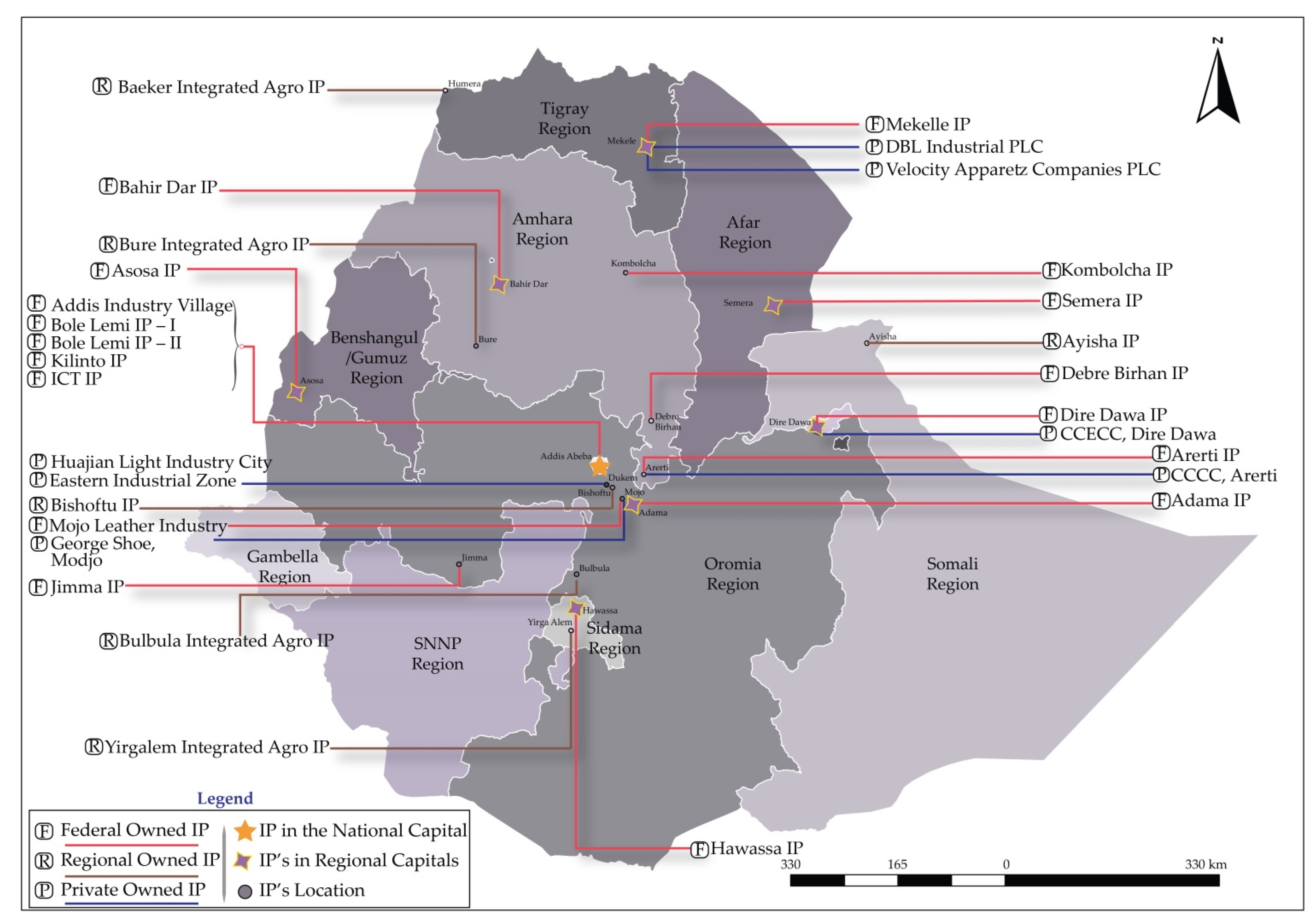
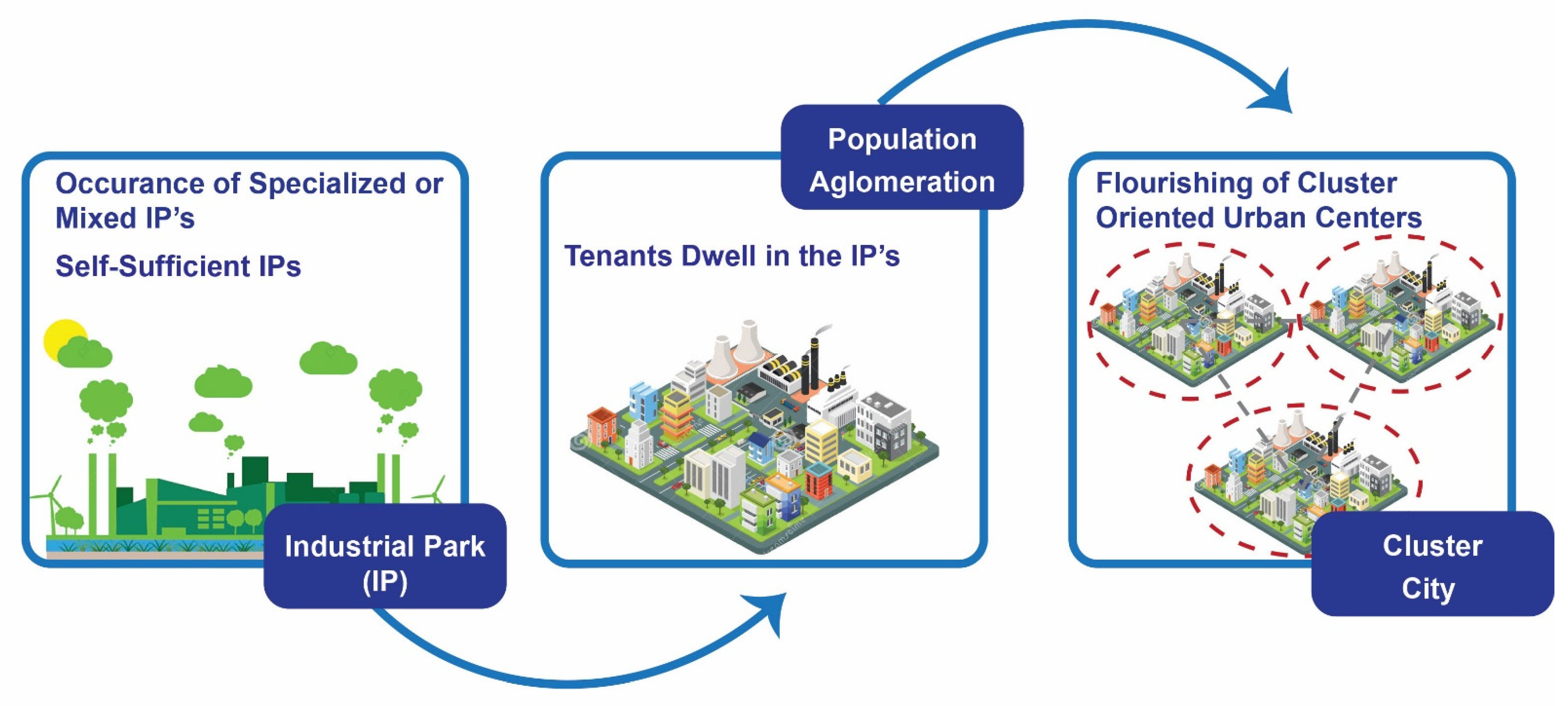
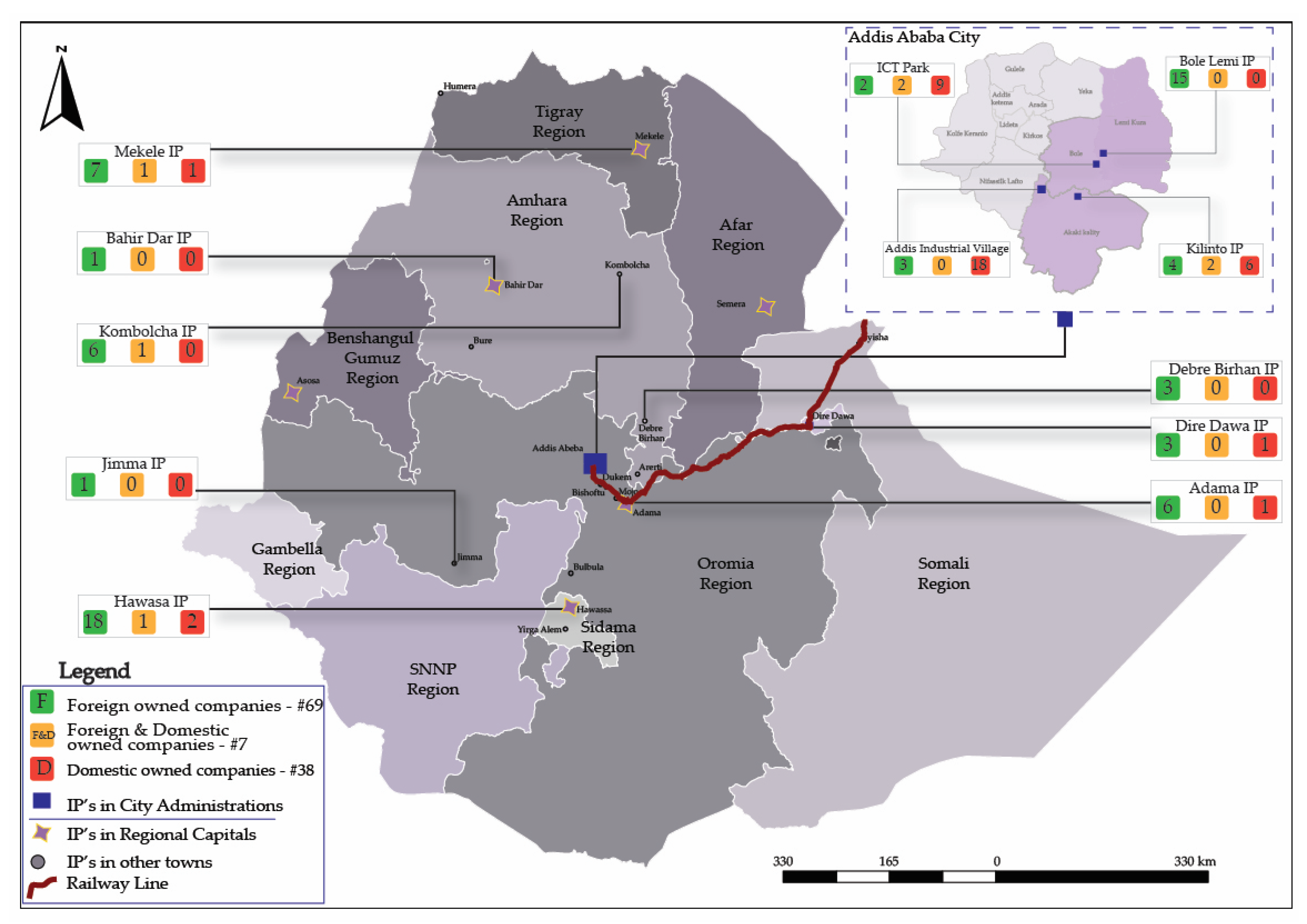

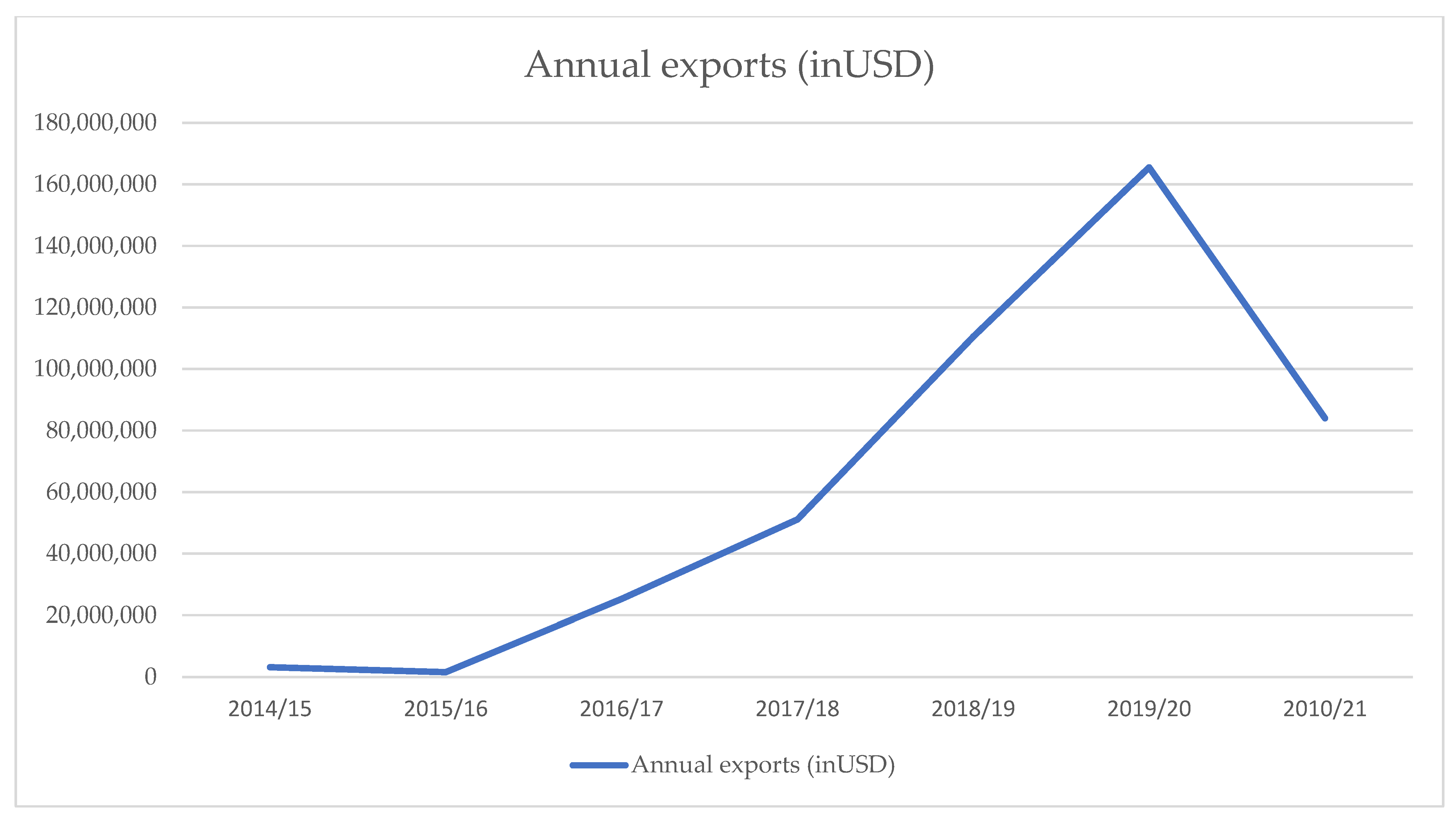
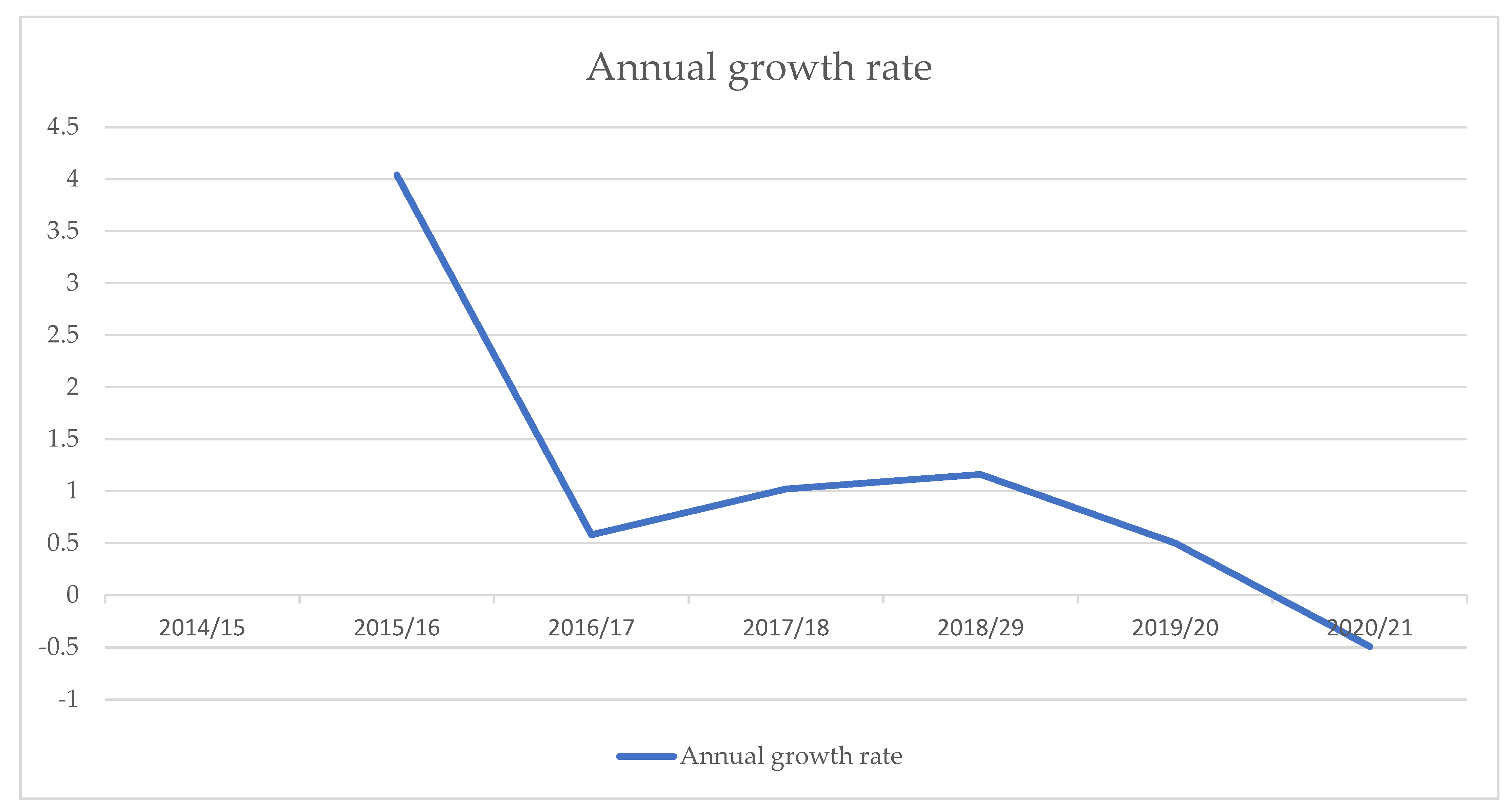
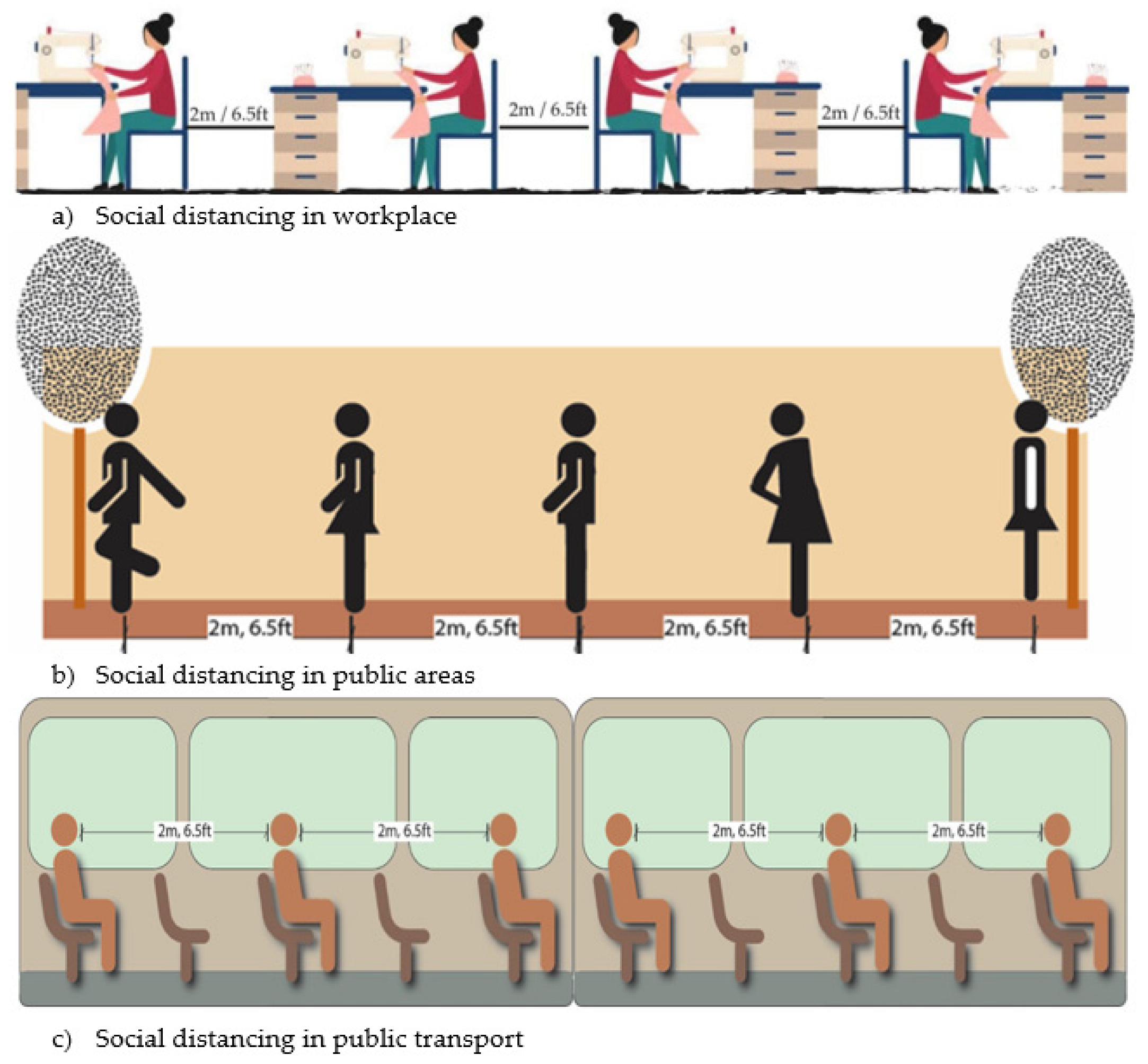

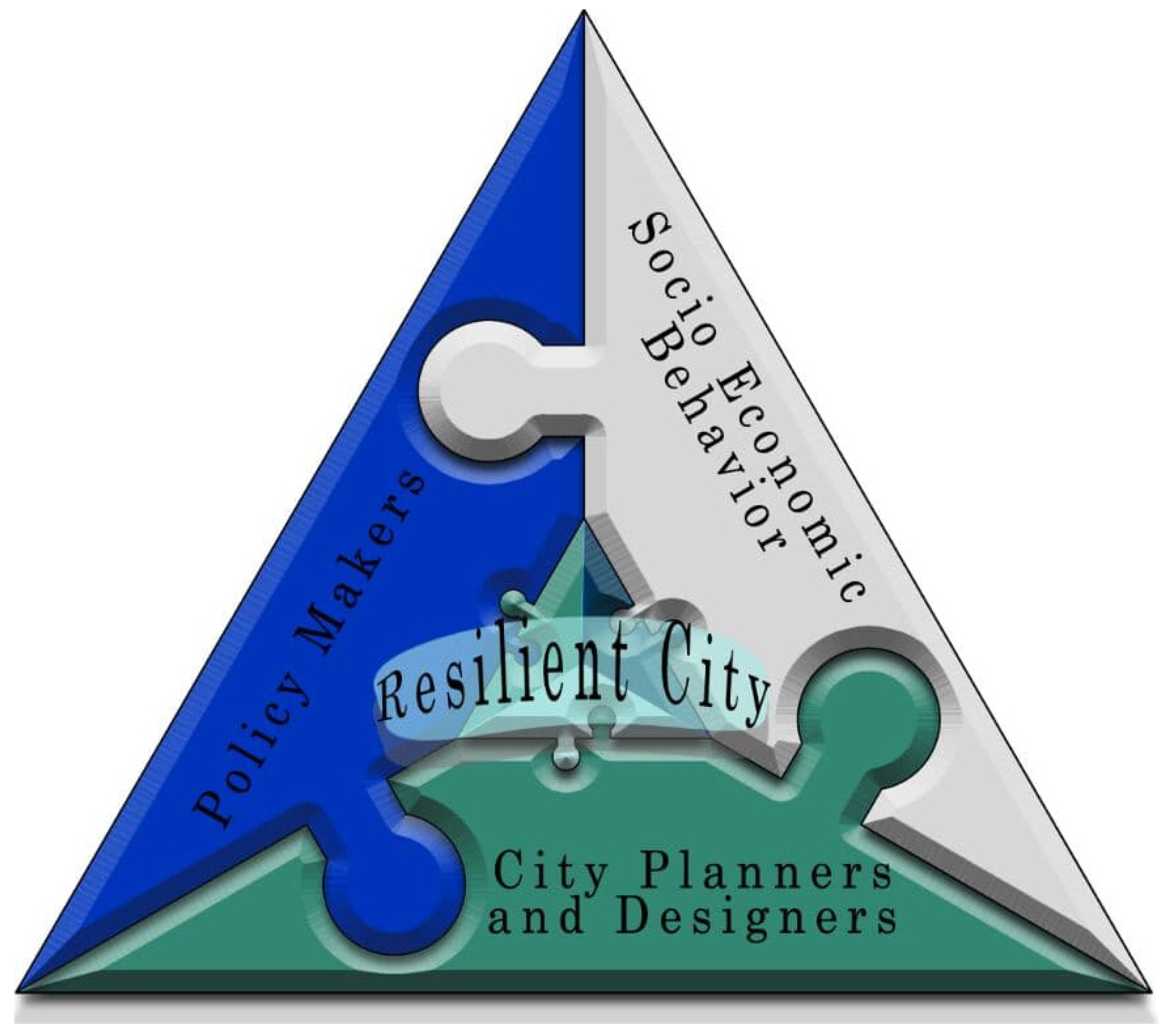
| Resilience Approach | Description |
|---|---|
| Engineering |
|
| Ecological |
|
| Adaptive |
|
| Period | Description |
|---|---|
| Imperial (1950s–1974) |
|
| Dergue (1974–1991) |
|
| FDRE (Since 1991) |
|
| S/N | IP Name | Location (Region) | Total Area (Ha) | Developed Area (Ha) | Adjacent Urban Center | Distance from the Nearest CBD |
|---|---|---|---|---|---|---|
| 1 | Bole Lemi | Addis Ababa | 353 | 172 | Addis Ababa | 15.4 |
| 2 | ICT Park | Addis Ababa | 200 | 200 | Addis Ababa | 14 |
| 3 | Kilinto | Addis Ababa | 279 | 279 | Addis Ababa | 20 |
| 4 | Hawassa | Sidama | 300 | 140 | Hawassa | 3.1 |
| 5 | Mekele | Tigray | 1000 | 75 | Mekele | 7.1 |
| 6 | Kombolcha | Amhara | 800 | 75 | Kombolcha | 4 |
| 7 | Adama | Oromia | 2000 | 120 | Adama | 8 |
| 8 | Dire Dawa | Dire Dawa | 4186 | 150 | Dire Dawa | 15.4 |
| 9 | Jimma | Oromia | 1000 | 75 | Jimma | 7.4 |
| 10 | Bahir Dar | Amhara | 2000 | 75 | Bahir Dar | 9.9 |
| 11 | Debre Birhan | Amhara | 1100 | 100 | Debre Birhan | 8.2 |
| S/N | IP Name | Location (Region) | Population | Urban Hierarchy |
|---|---|---|---|---|
| 1 | Bole Lemi | Addis Ababa | 50,000 | Intermediate city |
| 3 | ICT park | Addis Ababa | 240,000 | Tertiary city |
| 4 | Kilinto | Addis Ababa | 50,000 | Intermediate city |
| 5 | Hawassa | Sidama | 60,000 | Intermediate city |
| 6 | Mekele | Tigray | 20,000 | Large town |
| 7 | Kombolcha | Amhara | 13,000 | Small town |
| 8 | Adama | Oromia | 20,000 | Large town |
| 9 | Dire Dawa | Dire Dawa | 20,000 | Large town |
| 10 | Jimma | Oromia | 13,000 | Small town |
| 11 | Bahir Dar | Amhara | 13,000 | Small town |
| 12 | Debre Birhan | Amhara | 13,000 | Small town |
| Total | 462,000 | |||
| Year EFY (Gregorian) | Number of Investors | Annual Growth Rate |
|---|---|---|
| 2007 (2014/15) | 10 | |
| 2008 (2015/16) | 11 | 0.10 |
| 2009 (2016/17) | 26 | 1.36 |
| 2010 (2017/18) | 36 | 0.38 |
| 2011 (2018/19) | 47 | 0.31 |
| 2012 (2019/20) | 62 | 0.32 |
| 2013 (July 2020–December 2021) | 63 | 0.02 |
| Year EFY (Gregorian) | Number of Jobs | Annual Growth Rate |
|---|---|---|
| 2007 (2014/15) | 9119 | |
| 2008 (2015/16) | 9900 | 0.09 |
| 2009 (2016/17) | 21,250 | 1.15 |
| 2010 (2017/18) | 33,944 | 0.60 |
| 2011 (2018/19) | 50,125 | 0.48 |
| 2012 (2019/20) | 56,223 | 0.12 |
| 2013 (July 2020–December 2021) | 61,368 | 0.09 |
Publisher’s Note: MDPI stays neutral with regard to jurisdictional claims in published maps and institutional affiliations. |
© 2022 by the authors. Licensee MDPI, Basel, Switzerland. This article is an open access article distributed under the terms and conditions of the Creative Commons Attribution (CC BY) license (https://creativecommons.org/licenses/by/4.0/).
Share and Cite
Mengistu, D.T.; Gebremariam, E.; Wang, X.; Zhao, S. Pandemic-Resilient Urban Centers: A New Way of Thinking for Industrial-Oriented Urbanization in Ethiopia. Urban Sci. 2022, 6, 26. https://doi.org/10.3390/urbansci6020026
Mengistu DT, Gebremariam E, Wang X, Zhao S. Pandemic-Resilient Urban Centers: A New Way of Thinking for Industrial-Oriented Urbanization in Ethiopia. Urban Science. 2022; 6(2):26. https://doi.org/10.3390/urbansci6020026
Chicago/Turabian StyleMengistu, Daniel Tesfaw, Ephrem Gebremariam, Xingping Wang, and Shengbo Zhao. 2022. "Pandemic-Resilient Urban Centers: A New Way of Thinking for Industrial-Oriented Urbanization in Ethiopia" Urban Science 6, no. 2: 26. https://doi.org/10.3390/urbansci6020026
APA StyleMengistu, D. T., Gebremariam, E., Wang, X., & Zhao, S. (2022). Pandemic-Resilient Urban Centers: A New Way of Thinking for Industrial-Oriented Urbanization in Ethiopia. Urban Science, 6(2), 26. https://doi.org/10.3390/urbansci6020026





